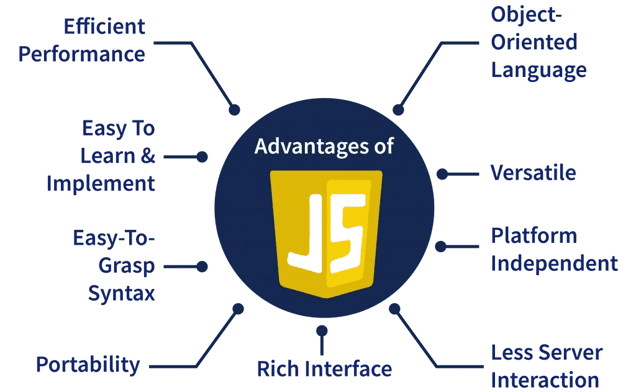Following Key Topics to Cover in JavaScript-
1) Introduction to JavaScript
- What is JavaScript?
- History and Evolution
- JavaScript in Web Development
- Basic Syntax and Structure
2) JavaScript Variables and Data Types
- Declaring Variables
- Primitive Data Types
- Complex Data Types
- Type Conversion
3) JavaScript Operators
- Arithmetic Operators
- Assignment Operators
- Comparison Operators
- Logical Operators
- Ternary Operator
4) JavaScript Control Flow
- Conditional Statements (if, else if, else)
- Switch Statement
- Loops (for, while, do-while)
- Break and Continue Statements
5) JavaScript Functions
- Defining Functions
- Function Parameters and Arguments
- Return Statement
- Anonymous Functions
- Arrow Functions
- Function Expressions vs Declarations
6) JavaScript Arrays
- Creating Arrays
- Accessing Array Elements
-
Array Methods (push, pop, shift, unshift, splice,
slice, etc.)
- Iterating Arrays
-
Array Iteration Methods (forEach, map, filter,
reduce)
7) JavaScript Objects
- Creating Objects
- Object Properties and Methods
- Accessing Object Properties
- Object Constructors
- Prototypes and Inheritance
- Object Destructuring
8) JavaScript Events
- Event Handling
- Event Listeners
- Mouse Events
- Keyboard Events
- Form Events
- Event Object
9) JavaScript DOM Manipulation
- Introduction to DOM (Document Object Model)
- Selecting DOM Elements
- Manipulating DOM Elements
- Creating and Removing DOM Elements
- Traversing the DOM
10) Asynchronous JavaScript
- Understanding Asynchronous Programming
- Callbacks
- Promise Object
- Async/Await
- Fetching Data with Fetch API
11) JavaScript Error Handling
- Try...Catch Statement
- Throw Statement
- Custom Error Handling
- Error Object
12) JavaScript ES6+ Features
- Let and Const
- Template Literals
- Arrow Functions
- Classes
- Modules
- Destructuring
- Spread and Rest Operators
- Default Parameters
Mastering JavaScript is essential for building
interactive and dynamic web applications. This
curriculum covers the fundamental topics needed to
become proficient in JavaScript programming. By
understanding these concepts, you can create engaging
user experiences and add interactivity to your web
projects. Best of luck with your learning journey!


